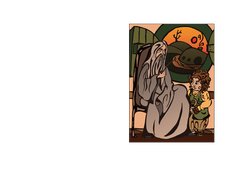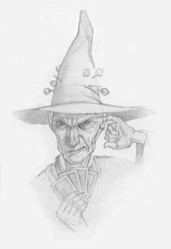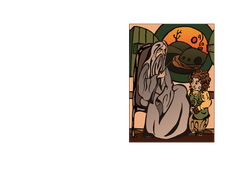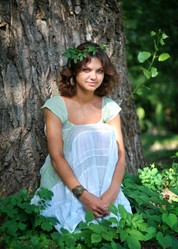Tolkien was an expert on philology, the study of sounds, and he studied this subject partly through the medium of myths. His study encompassed the myths of many nations, though he concentrated upon the myths of the European peoples. The Finnish myth of the Kalevala fascinated him. He delved deeply into Celtic myth, a delving that was reflected in the Silmarillion's recounting of the westward journey of the elves over the ice, which was drawn from the Irish myth of the coming of the Tuatha de Danaan from the West; and he pored long over Germanic myths. Tolkien shared with Jung a belief that myths were vehicles by which great truths of human life were expressed, and this means that they are culturally,morally and religiously important.Tolkien would never say "only a myth."
This is one of the reasons for his hatred of Naziism. Tolkien detested the works of Wagner, Hitler's musical hero, because of his corruption of Nordic mythology. He saw the dangers inherent in the corruption. For this reason, along with many other, he despised the poisonous rantings of Hitler, who used Wagner's twisted mythology to support his demonic cause. Therefore,the claim made by Andy Duncan in A Geeks' Guide to the Galaxy podcast [reported in The Times by Will Humphries] that Tolkien's heroes are all white and western and that therefore there is a degree of racism in his work must be taken in a qualified way and set against his general opposition to Naziism and its racist philosophy. Humphries informs us that in 1938 Tolkien refused a request from his German publisher to confirm his Aryan descent. This is not the action of a racist.
In fact, Tolkien's heroes, the hobbits, are subtly anti-Nazi. Naziism elevated the Aryan race over all other races, classing Aryans as Herrenvolk, noble people, promoting a belief in the superiority of Aryan blood. Aryans were classed as tall,fair skinned people with fair hair that hung limply without curls, and their body hair was quire sparse, unlike the darker skinned Latin races, who were thought to be hirsuit. Compare this to the hobbits, who are described in chapter 1 of The Hobbit as having brown curly hair, hairy feet [there, the body hair!] and brown fingers. The implication is that the hobbits were brown skinned.Unlike the supposed warrior Aryans, who were tall, hobbits are merely three feet tall and prefer avoiding trouble to fighting. It should be clear that Tolkien is in his work challenging racial stereotypes with a slightly comic alternative; and we can see that Andy Duncan's claim that Tolkien's heroes are all white immediately fails.
Furthermore, the Lord of the Rings is anti-Wagner, whose Nibelung saga is about the heroic quest to find a ring of power. The two hobbits, Frodo and Sam, are involved in a far greater heroic quest to destroy the ring of power. This ring magnifies the will of the one who wears it, but corrupts in the process. In telling of the destruction of this ultimate weapon, which is of diabolical origin, Tolkien is demonstrating a hostility to the Nazi cult of the will. We can sense in the book Tolkien's revulsion at the infamous Nazi propaganda film, The Triumph of the Will, produced by Hitler's film maker Leni Riefenstahl.
It is clear that the claims of racism are in these areas unfounded.










 TheThousand Year Gardenon 11/26/2025
TheThousand Year Gardenon 11/26/2025
 Women of the Gospelson 10/11/2025
Women of the Gospelson 10/11/2025
 Religious Gardenson 08/25/2025
Religious Gardenson 08/25/2025
 Doctor of the Church: John Henry Newmanon 08/03/2025
Doctor of the Church: John Henry Newmanon 08/03/2025




Comments
Thanks for that knowledge.
Thank you!
Interpreting west as west of Ireland leads to North America.
Some paintings make the Tuatha de Danaan light-eyed, light-haired, light-skinned.
The Aztec peoples moved from somewhere well northward of central Mexico. They initially received the Spanish conquistadores well because of a many-, many-centuries-old, historic interaction with similar-described peoples way, way north of Tenochtitlan.
The Spanish conquerors -- possibly Basques because of light eyes, light hair, light skin, tall stature -- somewhat, slightly, semi-similarized those northerners, who told the Aztec ancestors that they would return from across the northeastern waters.
If only we knew. The legend of the Tuatha De Danaan seems to use the word west in mythical space rather than objective space. So we cannot put a clear geographical value on the term west.
The first paragraph to the first subheading, Of Aryans and Hobbits, considers the "Irish myth of the coming of the Tuatha de Danaan from the West."
What western places did the Tuatha de Danaan come from?
Celtic societies were tribal and very warlike, but racism on grounds of ethnicity was not present.
frankbeswick, Thank you for the explications of J.R.R. Tolkien's ring trilogy. It's perhaps to be expected to try to understand the past by the present's standards even though that may lead to the misunderstandings that you mention. I mean no stereotyping in saying that I tend to think of Celtic culture as non-racist in its bases, such as those that J.R.R. Tolkien undoubtedly uncovered in all his research. My research suggests that anyone who could speak a Celtic language traditionally was considered Celtic in Celtic societies. How would that be racist?
Correct
Great article.
Racism needs to be clearly defined. Making a comment about someone's race isn't necessarily negative. A relative of mine admonished me severely when she asked if my 2 year old grandson was talking yet and I said well he does but it sounds like Serbo Croat to me. My grandson was non understandable at that age. I wasn't being negative about the Serbo Croat language or people. ( i don't speak Serbo Croat ) I don't think that any race is inferior. We are all equal in my eyes.
People are too quick to jump on the " racist " ticket. This in itself pushes true racism on a back burner.
You have undertaken a difficult topic, one that justice requires going against political correctness, and done a credible job. You wisdom and depth of thought here is rare to find. well done.
You have brought up a new point in Tolkien studies. It is what part the Old Testament played in his thought.